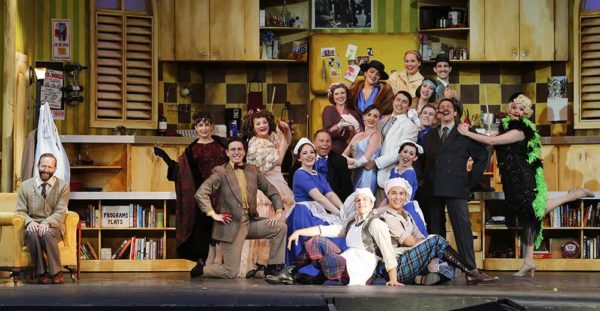
Cast of "The Drowsy Chaperone". Tim Matheson photo.
He arrives in his dingy apartment, delivering an entertaining (and audience-winking) rant about theatre, Broadway, and his fruitless search for a good story and some tuneful songs. To dispel his blue mood, he shares with us his favourite recording - the soundtrack to the (fictitious) 1920's musical, "The Drowsy Chaperone". As his vinyl record ("it's remastered from the original '78's!") spins, the characters of the show parade into his living room and kitchen (even entering and exiting via the fridge!), and we get to see and hear the characters and songs.
What follows is a whirl of top-notch dance, song and stagecraft that celebrates the frothy silliness of old-time, pre "Oklahoma" musicals, those shows that were chock-full of stock characters, predictable boy-meets-girl plots... and great melodies. "Chaperone" certainly delivers on all of this, including the melodies, with several standout numbers including "Toledo Surprise", "Show Off", "Bride's Lament" (aka "I Put a Monkey on a Pedestal") and the rousing tune that serves as the finale, "As We Stumble Along". I love them all.
The performances are excellent all around: Peter Stainton's "Underling", the butler, Lauren Gula's "Kitty" (who channels a squeaky-voiced Lina Lamont from "Singin' in the Rain"), Sheryl Anne Wheaton as the charmingly clueless Mrs. Tottendale, and Dimitrios Stephanoy as comical Latin lover "Aldolpho" (whose sudden entrances are reminiscent of Squiggy's on "Laverne and Shirley!).
There are some hilarious zingers from both the Man in Chair and the characters in the "show", and sharp choreography with some great tap dancing. And the chorus of dancing organ-grinder monkeys in the second act's "Bride's Lament" – capped off by an utterly adorable and very little monkey – was a delight.
There were also a couple of clever, funny shout-outs to TUTS' other production, Mary Poppins.
For me, however, there are indeed some "stumbles along" the way, inherent in the script and entirely separate from the outstanding performances, that keep this show from being truly great.
Early on, "Man in Chair" rhapsodizes over the idea of living in the 1920's and anticipating Gershwin or Porter's next score, wondering if it will be a hit. But this highlights something important: while the tunes that came from those great composers are now considered the "Great American Songbook", the shows themselves are largely forgotten. The aforementioned "Oklahoma", conversely, is considered a turning point for true integration of song and story into a unified whole.
Yet "Drowsy Chaperone" curiously revels in the flaws of those old-fashioned shows by emphasizing the stock, cliché nature of the characters within the fictional show. The figures of the "Chaperone" story simply announce who they are, and proceed to exemplify their cliche. As we skip merrily from one colourful showpiece to the next, we never get more than a perfunctory interchange between them.
It's a tribute to the charm and talent of the performers that we do care as much as we do about their characters, given the intentionally limited opportunities for character development.
The heart and soul of the show seem to both be missing in action until Act 2, when it becomes clear where they reside - in the "Man In Chair" himself. It's Shawn Macdonald's engaging performance, and the personal stories that slip out from him almost by accident, that truly ultimately make us care about him and what he's going through. "The Drowsy Chaperone" is the sort of cheerful and satisfying love story that he lacks in his own life, and dearly desires. When, near the end of the show, he alludes to his painfully failed marriage, my heart ached. I only wish it had been more engaged earlier with the musical tale being poured out around him.
So for me, "Drowsy Chaperone" was full of great stuff but didn't quite click. But it is still a very lively, colourful show with plenty to enjoy – especially if you give it a little time.